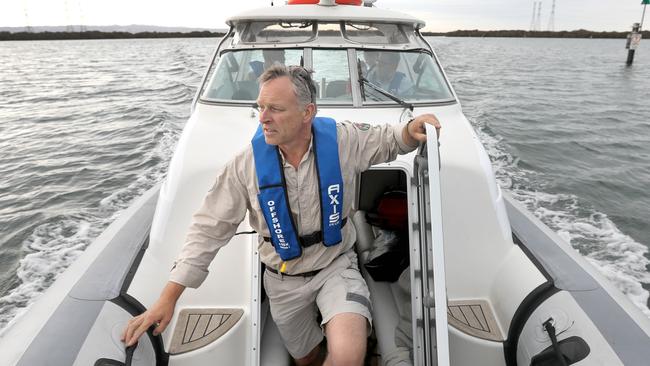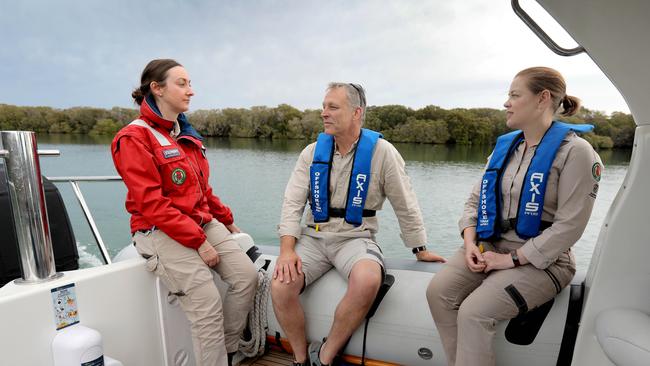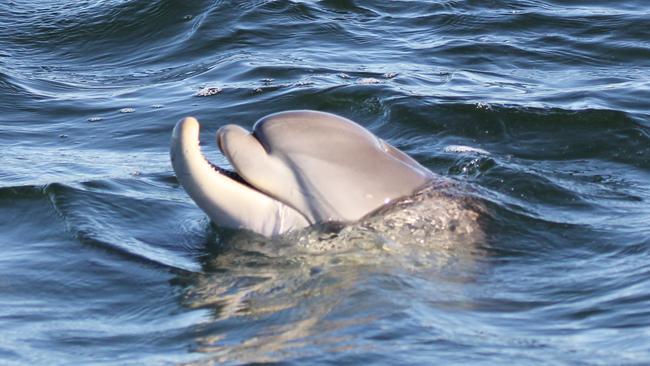Dolphin detectives and the controversial case of the Port River sanctuary deaths
A fourth – and highly contentious – dolphin sanctuary death was far from an ordinary event for the people tasked with protecting the creatures. Now their search for answers continues.

SA News
Don't miss out on the headlines from SA News. Followed categories will be added to My News.
For our marine park rangers, patrolling the Port River and the 118 square kilometres of the Adelaide Dolphin Sanctuary is a routine outing.
Keeping an eye on the beautiful bottlenose dolphins – and the boaties, fishers and paddlers that share the waters – is all part of the job.
And while that may appear idyllic, lately it’s been tinged with sadness.
The beloved dolphins have been dying, with three thought to have died in recent months in similar circumstances. A fourth, a six-year-old dolphin named Hunter, was euthanised by vets on October 22.
It was a controversial decision and one that National Parks and Wildlife Service admits is outside the usual procedures.
In most cases nature is left to take its course, with rangers only interfering to help dolphins that have been entangled in fishing line or rope or otherwise been obviously impacted by human activity.
It’s also been extremely controversial with dolphin volunteer groups, with some saying more should have been done to try to save Hunter.
It has even led to a petition – which has attracted more than 2500 signatures – calling for an inquiry into the incident and the sacking of NPWS marine parks regional co-ordinator Jon Emmett.

Mr Emmett said he understood the euthanising of a Port River dolphin was always going to be upsetting to those who love the animals, but he implored people to look at the bigger picture.
The ranger said when dolphins died in the wild their bodies were rarely found and, had Hunter been left to die in the river, any clues to what might be killing the cetaceans would be gone forever.
“In this case I really think we need to look at the big picture,” Mr Emmett said.
“If the action that we took helps to save the population of dolphins, or at least learn what it is that’s causing this, then that’s a good outcome.
“This is something that we did under the guidance of very experienced wildlife vets.”
The post-mortem on Hunter – whose death followed the suspected losses this year of dolphins Doc and Twinkle, and the confirmed death of a dolphin named Tallula – showed he had a severe bacterial infection in his left ear which had damaged surrounding bones.
“This would have permanently affected his ability to hunt and forage,” University of Adelaide associate professor in veterinary pathology Lucy Woolford said.

“He also had multiple skin abscesses over his body, which are known to be associated with disease-causing bacteria leading to infection and death in marine mammals.
“Further testing of the skin cultures will help us to gain insight into the strains which caused the infection.”
Dr Woolford said Hunter’s stomach was almost empty, with only four small shrimp found, and he was suffering from intestinal bleeding.
She said there were “significant concerns” Hunter and the other dolphins that died in the sanctuary this year might have suppressed immunity for reasons that were still unclear.
Dr Woolford said a full investigation, which involved specialist labs across several states, would take several weeks.
“The dolphins have to live in that area and compete with all of those activities,” she said.
One of those who believes more could possibly have been done for Hunter is Aaron Machado, president and founder of the Australian Marine Wildlife Research and Rescue Organisation based at Torrens Island.
“Hunter had congenital defects at birth so his story was probably never going to end well,” Mr Machado said of the dolphin that was born with a deformed jaw.
“But there was a bunch of stuff in the post-mortem report that I don’t interpret the way they have.
“There was never any question he was sick but was it the right move to euthanise him? Should it have been done differently? I believe so, but in the end it wasn’t my call.”
Mr Emmett said Adelaide was blessed to have a permanent population of dolphins so close to a capital city but it came with unique challenges.
“They live in the state’s busiest port, with a lot of shipping, a lot of industry and a lot of recreational use,” he said.




